


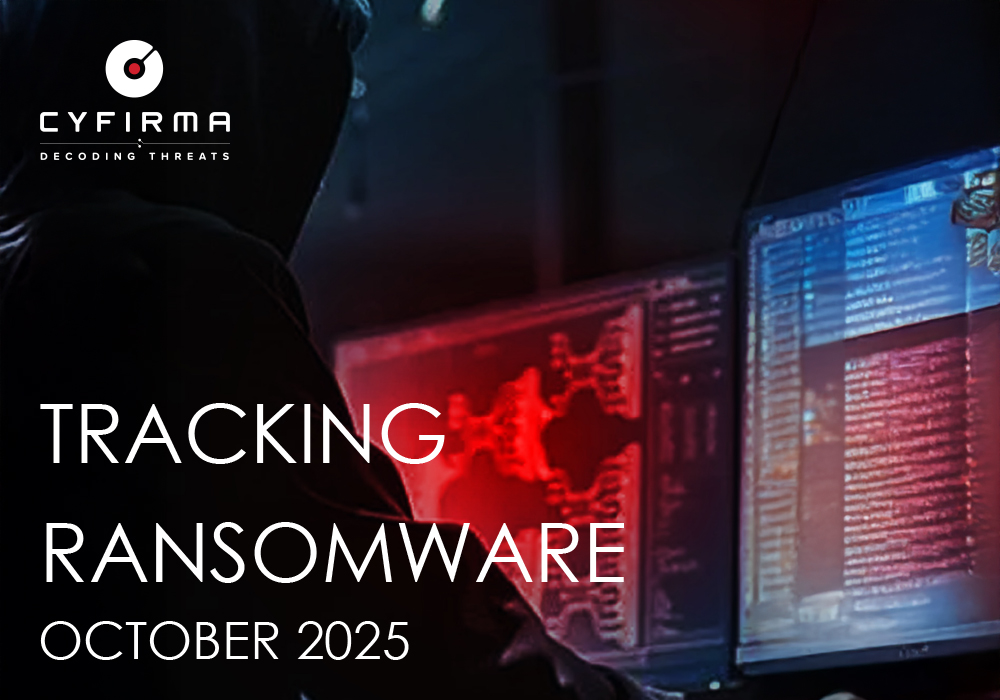
In October 2025, ransomware activity surged globally, marking a significant resurgence after a period of mid-year stability. Victim counts climbed to 738, driven by renewed campaigns from leading operators and the emergence of several new groups. Qilin more than doubled its attacks to 181 victims, while Sinobi expanded sixfold, signaling aggressive growth among established actors. At the same time, new entrants such as Black Shrantac, Coinbase Cartel, and GENESIS intensified the threat landscape, collectively contributing to a rise in targeted data extortion campaigns. Attackers increasingly exploited kernel-level vulnerabilities, runtime environments, and trusted code-signing mechanisms, revealing a shift toward stealthier, hybrid attack models that evade traditional endpoint defenses. Industries most affected included Professional Services, Manufacturing, Information Technology, and Healthcare, with attackers focusing on sectors offering high disruption potential and ransom leverage. Geographically, the United States remained the epicenter of global ransomware activity, followed by Canada, France, and Germany, while expanding campaigns across Asia and the Middle East signaled a broader international reach. October also marked the rise of industrial extortion, exemplified by the Asahi Breweries incident, where ransomware caused direct operational disruption. Overall, October 2025 underscored a new phase of technical sophistication and industrial targeting, as ransomware evolved from data encryption to strategic business disruption, leveraging downtime, reputational damage, and financial pressure as its primary extortion tools.
Welcome to the October 2025 Ransomware Threat Report. This report delivers a detailed analysis of the ransomware landscape, highlighting the emergence of new ransomware groups, evolving attack techniques, and notable shifts in targeted industries. By examining key trends, tactics, and significant incidents, this report aims to support organizations and security teams in understanding the current threat environment. As ransomware campaigns continue to grow in complexity, this report serves as a vital resource for anticipating future threats and strengthening proactive cybersecurity strategies.
Throughout October, there was notable activity from several ransomware groups.
Here are the trends regarding the top 5:
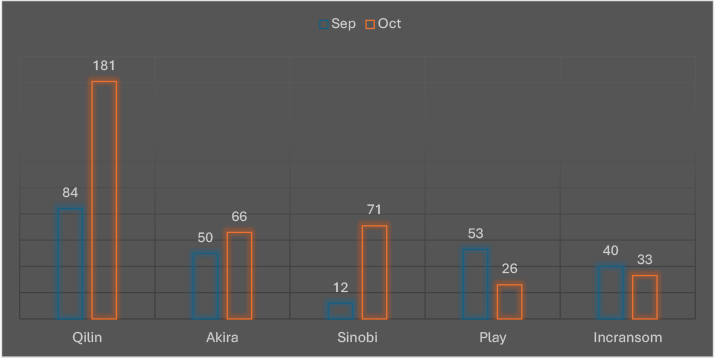
The October comparison reveals major shifts in ransomware group activity. Qilin exhibited explosive growth, more than doubling its victims from 84 to 181, reinforcing its position as a dominant and rapidly expanding threat. Sinobi surged dramatically as well, rising from 12 to 71 incidents, a nearly sixfold increase that marks its emergence as a significant player. Akira showed moderate growth, climbing 32% (50 to 66), suggesting steady operational expansion. In contrast, Play experienced a sharp decline of 51% (53 to 26), indicating reduced campaign activity or strategic regrouping. Incransom also dipped slightly by 17.5% (40 to 33). These fluctuations highlight the evolving dynamics of the ransomware landscape, where new and resurging actors are rapidly gaining ground while others lose momentum.

Ransomware operators intensified their focus on high-value and data-rich industries, with the Professional Goods & Services sector suffering the highest number of victims at 154, marking a sharp escalation from prior months. Manufacturing (145) and Information Technology (139) closely followed, underscoring sustained targeting of sectors vital to global supply chains and digital infrastructure. The Consumer Goods & Services (143) and Healthcare (113) sectors also faced heavy pressure, reflecting adversaries’ continued exploitation of industries with critical operations and strong ransom payment incentives.
Notably, Materials (101) and Real Estate & Construction (128) recorded substantial victim counts, signaling attackers’ growing interest in upstream and infrastructure-linked verticals. Finance (86) and Government & Civic (65) sectors remained consistent targets, highlighting persistent risk to both financial institutions and public entities. Mid-level exposure was observed in Transportation & Logistics (45), Telecommunications & Media (43), Education (36), and Energy & Utilities (32), while the Automotive sector (27) saw a meaningful uptick, suggesting ransomware groups’ expanding reach across industrial supply chains.
Overall, October’s landscape reflects a surge in campaigns against professional services and production-centric industries, revealing a deliberate pivot toward sectors offering high disruption potential and significant ransom leverage.

Ransomware activity surged sharply in October, marking a major rebound after several months of relative stability. Victim counts jumped to 738, up from 545 in September, signaling renewed momentum across multiple ransomware groups. This spike likely reflects the return of previously dormant affiliates, the launch of new large-scale campaigns, and intensified targeting of high-value sectors, such as professional services, manufacturing, and IT. The October surge follows a mid-year lull driven by affiliate realignments and tactical shifts toward stealthier intrusions, highlighting that ransomware operations remain highly adaptive and opportunistic. Overall, October’s escalation highlights a clear resurgence in activity, reaffirming ransomware’s position as one of the most persistent and evolving cyber threats of 2025.
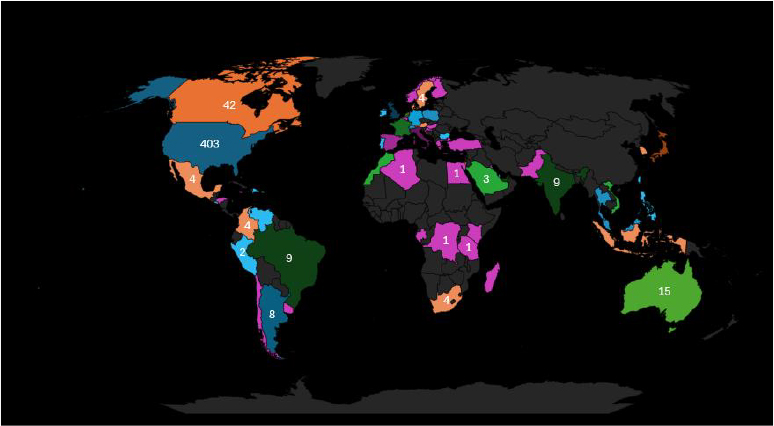
In October, the United States remained the primary target of ransomware activity, recording 403 victims, a figure far surpassing any other nation and reaffirming its position as the epicenter of global ransomware operations. Canada (42) and France (31) followed at a distance, with Germany (22), Spain (16), Australia (15), and the United Kingdom (13) also sustaining high levels of targeting. Emerging hotspots included Japan, the UAE, India, and Brazil (9 each), reflecting ransomware actors’ growing focus on Asia and the Middle East. Meanwhile, Argentina (8), Italy (7), and the Netherlands (6) continued to experience steady exposure, alongside a broader cluster of countries, such as Poland, Hong Kong, Switzerland, Thailand, and Malaysia (5 each) that demonstrate the widening global distribution of attacks. Numerous smaller-scale incidents spanning Europe, Africa, and Latin America further reaffirm the geographically dispersed nature of ransomware operations. Overall, October’s data highlights an intensifying global footprint, with adversaries maintaining a stronghold in digitally mature, ransom-prone economies while strategically expanding into diverse emerging markets to maximize reach and impact.
Roots of Control: Ransomware’s Descent into the Kernel
The exploitation of CVE-2024-1086 marks a notable evolution in ransomware strategy, shifting from pure software exploitation to weaponizing privilege escalation flaws within core Linux kernel components. By leveraging a year-old netfilter weakness, threat actors demonstrate increasing sophistication in adapting traditional system vulnerabilities into cross-platform ransomware entry points.
ETLM Assessment:
Future ransomware operations may integrate kernel-level privilege escalation exploits into automated intrusion kits, expanding attack surfaces beyond endpoints to servers and cloud-native workloads, enabling deeper persistence and faster privilege dominance.
Bridging Subsystems: Lateral Reach into Hybrid Environments
Qilin’s use of WSL to run Linux ELF encryptors on Windows signals a tactical convergence: attackers are exploiting runtime layers and legitimate tooling to bypass Windows-centric EDRs. Combined with Bring Your Own Vulnerable Driver (BYOVD) abuse and remote-management toolchains, this shows a shift toward hybrid, cross-runtime attacks that target both host and virtualized/cloud workloads while blending living-off-the-land techniques with kernel-level tampering.
ETLM Assessment:
Expect operators to weaponize other runtime features (containers, WSL2, Windows features) and automate multi-runtime payload delivery, while increasing kernel/driver abuse for stealth and persistence. Defenders will face more encrypted toolchains that pivot across OS boundaries and target cloud/VM infrastructures directly.
Trust as a Vector: The New Face of Ransomware Delivery
Rhysida’s campaign through malicious Teams installers reveals a maturing ransomware ecosystem that now blends malvertising, code-signing abuse, and social engineering under trusted brand impersonation. By exploiting legitimate signing authorities and exploiting user trust in Microsoft’s software ecosystem, Vanilla Tempest demonstrates how ransomware operations have evolved from brute intrusion to precision deception via supply-chain-like delivery vectors.
ETLM Assessment:
Future operations may pivot toward signed SaaS installers, browser extensions, and productivity integrations as infection vectors, leveraging user familiarity and verified code to bypass endpoint and browser defenses. The growing abuse of trusted signing infrastructure hints at a larger shift toward credibility-based intrusion models.
Turning the Tools of Defense into Weapons of Persistence
The use of Velociraptor, a legitimate DFIR tool, in LockBit and Babuk ransomware operations reflects a strategic inversion of defensive technology into offensive persistence. Threat actors like Storm-2603 are now embedding blue-team tooling into attacks to achieve stealthy remote control, privilege escalation, and recovery-resistant persistence — demonstrating a sophisticated convergence between offensive tradecraft and defensive instrumentation.
ETLM Assessment:
Adversaries may increasingly weaponize open-source security frameworks (e.g., Velociraptor, Osquery, GRR) for covert operations, turning the defender’s ecosystem into a post-exploitation toolkit. Expect a future wave of “dual use” tool exploitation, where forensic and monitoring agents become long-term backdoors within enterprise environments.
Bottling Disruption: When Ransomware Targets the Assembly Line
Qilin’s breach of Asahi Breweries highlights the industrial pivot of ransomware operations toward high-value manufacturing and supply chain disruption. By directly impacting production across multiple facilities and exfiltrating sensitive corporate data, Qilin demonstrates the maturation of ransomware from data theft to operational sabotage targeting revenue continuity and brand stability as extortion leverage.
ETLM Assessment:
Expect ransomware groups like Qilin to further integrate OT (Operational Technology) targeting and timed disruption strategies to maximize financial and reputational pressure. Future iterations may employ automated shutdown triggers or supply chain manipulation, evolving attacks from IT compromise to full-scale business interruption.
From Access to Extortion: The Modular Evolution of XWorm
The resurfacing of XWorm with over 35 plugins and a built-in ransomware module represents a critical shift from specialized malware to multi-functional attack platforms. Evolving from a simple RAT into a modular ecosystem, XWorm now merges espionage, data theft, and encryption capabilities, signaling the convergence of infostealers, botnets, and ransomware into single, adaptive frameworks controlled by diverse threat actors.
ETLM Assessment:
Future XWorm variants may transition into plug-and-play cybercrime kits, integrating AI-driven payload orchestration and autonomous decision-making for payload deployment. Expect further code reuse across ransomware families and the emergence of marketplace ecosystems where modules are traded or leased to lower-tier actors.
Black Shrantac
Black Shrantac is an emerging ransomware group that has continued to gain momentum through 2025, expanding its footprint across multiple sectors. In October, the group claimed 14 victims, up from 8 in September, indicating a steady escalation in activity and operational reach. Black Shrantac remains focused on data exfiltration and extortion, leveraging its dedicated leak sites to publicly expose stolen information and exert reputational and financial pressure on victims. The increase in October underscores the group’s growing sophistication and confidence, positioning it as an early-stage but fast-maturing threat actor with the potential to evolve into a more prominent player in the ransomware landscape.
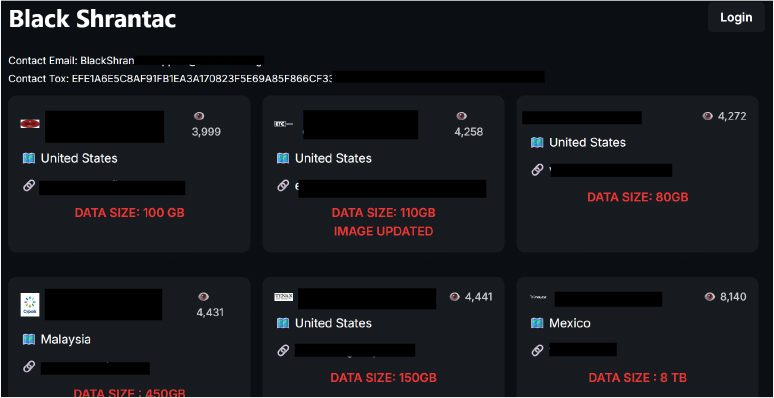
Coinbase Cartel
Coinbase Cartel is an emerging ransomware and data extortion group that continued to attract attention in 2025 for its methodical and financially driven operations. In October, the group claimed 12 victims, primarily focusing on online platforms and web services. Known for publishing stolen data on its dedicated leak sites, Coinbase Cartel maintains an emphasis on financial and reputational coercion rather than large-scale encryption-based attacks. The slight decline in victim count from September suggests a strategic consolidation phase, as the group refines its targeting and operational methods, reinforcing its position as a structured and evolving threat actor with potential for sustained activity in the coming months.

GENESIS
GENESIS is a newly emerged ransomware and data extortion group that surfaced in October, quickly gaining traction with 12 confirmed victims across sectors such as legal services, healthcare, finance, manufacturing, retail, and professional services. The group primarily focuses on data exfiltration and public leaks rather than encryption, using exposure to exert financial and reputational pressure on its victims. Its early activity demonstrates a strategic targeting approach concentrated on U.S.-based organizations handling sensitive or regulated data. GENESIS’s rapid emergence, structured operations, and consistent disclosure pattern suggest a well-organized and potentially experienced actor, positioning it as a notable new entrant with strong potential for escalation within the ransomware ecosystem.
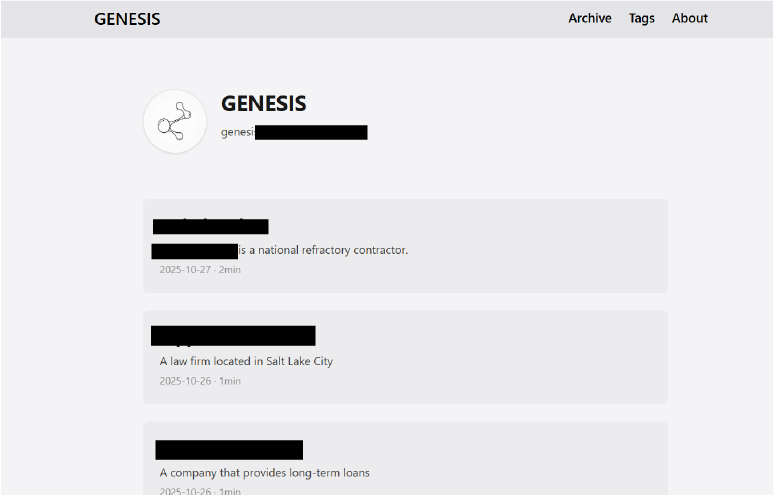
When Operations Halt: The Rising Cost of Industrial Extortion
Asahi’s confirmation of a ransomware-driven outage demonstrates how targeted attacks on industrial enterprises are escalating from data-centric extortion to production paralysis. The group’s quick transition to manual operations reflects both resilience and the growing reality that ransomware campaigns now aim for business process disruption rather than mere encryption, weaponizing downtime as leverage.
ETLM Assessment:
Future ransomware campaigns will likely focus on synchronized disruptions across IT and OT systems, exploiting production scheduling, logistics, and order management dependencies. The next wave of industrial ransomware could incorporate automation-aware payloads capable of halting supply chains at scale to amplify negotiation pressure.
Based on available public reports, approximately 31% of enterprises are compelled to halt their operations, either temporarily or permanently, in the aftermath of a ransomware onslaught. The ripple effects extend beyond operational disruptions, as detailed by additional metrics:
Ransomware remains a major threat to both organizations and individuals, locking critical data and demanding payment for its release. The consequences extend well beyond the ransom, often leading to costly recovery efforts, extended downtime, reputational harm, and potential regulatory fines. Such disruptions can destabilize operations and erode stakeholder trust. Addressing this growing risk demands a proactive cybersecurity posture and stronger collaboration between public and private sectors to build resilience against future attacks.
Cybercriminals are increasingly targeting industries that manage vast amounts of sensitive data, ranging from personal and financial information to proprietary assets. Sectors such as manufacturing, real estate, healthcare, FMCG, e-commerce, finance, and technology remain high on the threat radar due to their complex and extensive digital infrastructures. Adversaries strategically exploit vulnerabilities in economically advanced regions, launching well-planned attacks designed to encrypt critical systems and extract significant ransom payments. These operations are calculated to yield maximum financial returns.
The ransomware threat landscape in October revealed a shift toward modular, evasive, and high-impact operations. While overall victim numbers declined slightly, key groups like Qilin demonstrated technical maturity by exploiting zero-day vulnerabilities and introducing legal pressure tactics. Emerging groups such as Fog and Anubis showcased complex toolchains, indicating a strategic pivot to stealth and long-term compromise. Established actors also began leveraging legitimate tools and cloud platforms for persistence and data exfiltration. Organizations must enhance resilience, as ransomware now operates as a service ecosystem, rapidly adapting to security counter measures.
Strengthen cybersecurity measures: Invest in robust cybersecurity solutions, including advanced threat detection and prevention tools, to proactively defend against evolving ransomware threats.
Employee training and awareness: Conduct regular cybersecurity training for employees to educate them about phishing, social engineering, and safe online practices to minimize the risk of ransomware infections.
Incident response planning: Develop and regularly update a comprehensive incident response plan to ensure a swift and effective response in case of a ransomware attack, reducing the potential impact and downtime.
Cyber Insurance: Evaluate and consider cyber insurance policies that cover ransomware incidents to mitigate financial losses and protect the organization against potential extortion demands.
Security audits: Conduct periodic security audits and assessments to identify and address potential weaknesses in the organization’s infrastructure and processes.
Security governance: Establish a strong security governance framework that ensures accountability and clear responsibilities for cybersecurity across the organization.
Patch management: Regularly update software and systems with the latest security patches to mitigate vulnerabilities that threat actors may exploit.
Network segmentation: Implement network segmentation to limit the lateral movement of ransomware within the network, isolating critical assets from potential infections.
Multi-Factor authentication (MFA): Enable MFA for all privileged accounts and critical systems to add an extra layer of security against unauthorized access.